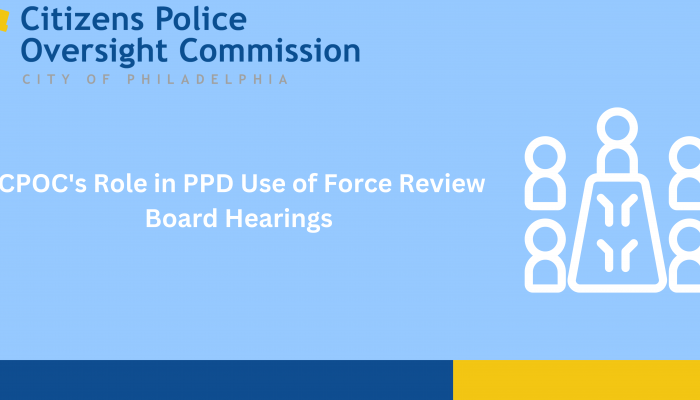When a member of the Philadelphia Police Department (PPD) is involved in a shooting, the department’s Officer Involved Shooting Investigation Unit (OISI) conducts a criminal investigation to determine if the involved officer violated any laws that warrant the District Attorney’s office to pursue criminal charges. In these incidents, the term “shooting” means any time an officer discharges their weapon, even if the discharge is accidental.
The PPD’s Internal Affairs Division (IAD) also conducts an administrative investigation to determine if the officer’s actions are within departmental policy. IAD presents their findings to the Use of Force Review Board (UFRB). Members of the Board include CPOC’s Executive Director, along with the following PPD personnel:
- The Deputy Commissioner, Organizational Services, who acts as the chairperson for the board (PPD).
- The Deputy Commissioner, Office of Professional Responsibility (PPD).
- The Deputy Commissioner, Patrol Operations (PPD).
- The Deputy Commissioner, Investigations (PPD).
The President of the Fraternal Order of Police (FOP) Lodge 5, or their designated appointee is present for UFRB meetings, but does not vote on incidents presented to the board.
The Board reviews the incident, which includes watching any related videos, and votes on whether an officer acted in or out of department policy. The Board will also make recommendations to the Police Commissioner for the incident to be sent for disciplinary charging, for the officer to receive additional training, or for the department to conduct a review of PPD’s policies and training methods.
During UFRB meetings, the board will collectively analyze the investigative findings and available evidence to conduct a thorough review of the incident. If necessary, the board may call witnesses and ask questions to inform their decisions.
When CPOC receives UFRB cases, CPOC’s Executive Director will assign those cases to members of CPOC’s Policy Unit and Investigations Unit. IAD will send UFRB cases to CPOC approximately once a month. The files include a completed investigation by IAD and OISI, and related photos, video, and witness statements. CPOC staff thoroughly review incidents, reading OISI and UFRB investigations, reviewing Department directives, examining evidence photographs and videos. Staff then prepare a written memo and hold a meeting to brief the Executive Director prior to the Use of Force Review Board meeting.
During a UFRB meeting, the board will vote on one of the following determinations:
- Administrative Approval (Justified): The officer’s actions were within departmental policy.
- Improve Tactics and/or Decision Making (Justified – Tactical and/or Decision Training Recommended): The officer’s actions were within policy but their tactics and/or decision making could be improved.
- No Use of Force Violations, but Other Departmental Violation Discovered (Justified – Use of Force; Other Departmental Violations – Not within Policy): The officer’s actions were in accordance with PPD use of force policies, but other policy violations occurred unrelated to the force used by the officer.
- Policy or Departmental Training Issues (Justified – Review of Departmental Policy or Training Recommended): The board determines the incident to be the result of a gap in PPD policy or training.
- Administrative Disapproval/Policy Violation (Not within Departmental Policy): The officer’s actions violated departmental policy or were deemed unreasonable, unnecessary, or excessive.
CPOC’s participation in the UFRB process is one example of how the agency works with the police department to ensure that officers are held accountable for their actions when they discharge their firearms, the most serious action an officer can take. This collaboration also provides effective oversight when officers are using deadly force within department policy.
For more information on the UFRB process, click here for the PPD’s written Directive 10.4: Use of Force Review Board.
The PPD posts information and outcomes of all officer involved shootings to their website. Click here to be directed to the PPD’s OIS dashboard.




